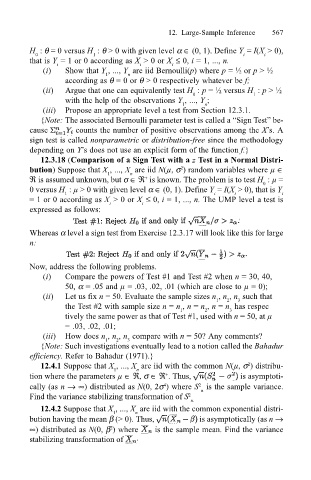Page 590 - Probability and Statistical Inference
P. 590
12. Large-Sample Inference 567
H : θ = 0 versus H : θ > 0 with given level α ∈ (0, 1). Define Y = I(X > 0),
1
i
i
0
that is Y = 1 or 0 according as X > 0 or X ≤ 0, i = 1, ..., n.
i
i
i
(i) Show that Y , ..., Y are iid Bernoulli(p) where p = ½ or p > ½
n
1
according as θ = 0 or θ > 0 respectively whatever be f;
(ii) Argue that one can equivalently test H : p = ½ versus H : p > ½
0 1
with the help of the observations Y , ..., Y ;
n
1
(iii) Propose an appropriate level a test from Section 12.3.1.
{Note: The associated Bernoulli parameter test is called a Sign Test be-
cause counts the number of positive observations among the Xs. A
sign test is called nonparametric or distribution-free since the methodology
depending on Ys does not use an explicit form of the function f.}
12.3.18 (Comparison of a Sign Test with a z Test in a Normal Distri-
bution) Suppose that X , ..., X are iid N(µ, σ ) random variables where µ ∈
2
n
1
ℜ is assumed unknown, but σ ∈ ℜ is known. The problem is to test H : µ =
+
0
0 versus H : µ > 0 with given level α ∈ (0, 1). Define Y = I(X > 0), that is Y
1 i i i
= 1 or 0 according as X > 0 or X ≤ 0, i = 1, ..., n. The UMP level a test is
i
i
expressed as follows:
Whereas α level a sign test from Exercise 12.3.17 will look like this for large
n:
Now, address the following problems.
(i) Compare the powers of Test #1 and Test #2 when n = 30, 40,
50, α = .05 and µ = .03, .02, .01 (which are close to µ = 0);
(ii) Let us fix n = 50. Evaluate the sample sizes n , n , n such that
1
3
2
the Test #2 with sample size n = n , n = n , n = n has respec
3
1
2
tively the same power as that of Test #1, used with n = 50, at µ
= .03, .02, .01;
(iii) How does n , n , n compare with n = 50? Any comments?
1
3
2
{Note: Such investigations eventually lead to a notion called the Bahadur
efficiency. Refer to Bahadur (1971).}
2
12.4.1 Suppose that X , ..., X are iid with the common N(µ, σ ) distribu-
n
1
tion where the parameters µ ∈ ℜ, σ ∈ ℜ . Thus, is asymptoti-
+
cally (as n → ∞) distributed as N(0, 2σ ) where S is the sample variance.
4
2
n
Find the variance stabilizing transformation of S 2
n.
12.4.2 Suppose that X , ..., X are iid with the common exponential distri-
1 n
bution having the mean β (> 0). Thus, is asymptotically (as n →
2
∞) distributed as N(0, β ) where is the sample mean. Find the variance
stabilizing transformation of .

